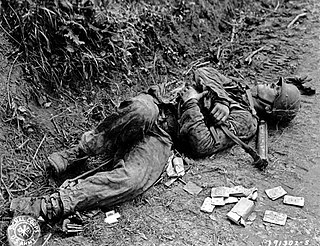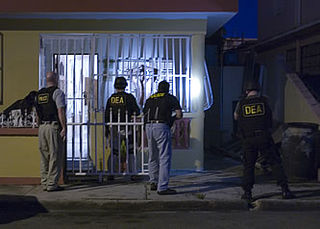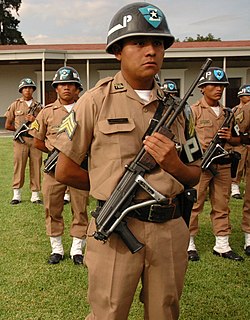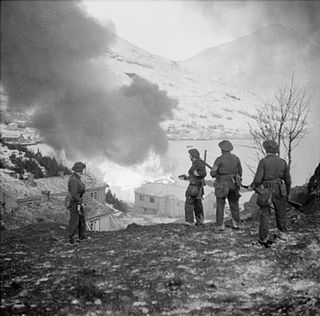The United States Armed Forces are the military forces of the United States of America. It consists of the Army, Marine Corps, Navy, Air Force, and Coast Guard. The president of the United States is the commander-in-chief of the Armed Forces and forms military policy with the Department of Defense (DoD) and Department of Homeland Security (DHS), both federal executive departments, acting as the principal organs by which military policy is carried out. All five armed services are among the seven uniformed services of the United States.

A noncommissioned officer (NCO) is a military officer who has not earned a commission. Non-commissioned officers usually obtain their position of authority by promotion through the enlisted ranks. In contrast, commissioned officers usually enter direct from a military academy, and are often expected to have a university degree.

Military police (MP) are law enforcement agencies connected with, or part of, the military of a state.

The Honorable Service Lapel Button, sometimes called the Honorable Service Lapel Pin, was awarded to United States military service members who were discharged under honorable conditions during World War II. The award is sometimes colloquially called the Ruptured Duck. Sculptor Anthony de Francisci designed the award.
The National Personnel Records Center(s) (NPRC) is an agency of the National Archives and Records Administration, created in 1966. It is part of the National Archives federal records center system and is divided into two large Federal Records Centers located in St. Louis, Missouri and Valmeyer, Illinois. The term "National Personnel Records Center" is often used interchangeably to describe both the physical Military Personnel Records Center facility and as an overall term for all records centers in the St. Louis area. To differentiate between the two, the broader term is occasionally referred to as the "National Personnel Records Centers".

The Kenpeitai) was the military police arm of the Imperial Japanese Army from 1881 to 1945. It was both a conventional military police and a secret police force. In Japanese-occupied territories, the kenpeitai also arrested those who were suspected of being anti-Japanese. While it was institutionally part of the army, the Kenpeitai also discharged the functions of the military police for the Imperial Japanese Navy under the direction of the Admiralty Minister, those of the executive police under the direction of the Home Minister and those of the judicial police under the direction of the Justice Minister. A member of the corps was called a kenpei.
A service number is an identification code used to identify a person within a large group. Service numbers are most often associated with the military; however, they may be used in civilian organizations as well. Social Security Numbers may be seen as types of service numbers.

A casualty, as a term in military usage, is a person in military service, combatant or non-combatant, who becomes unavailable for duty due to several circumstances, including death, injury, illness, capture or desertion.
The DD Form 214, Certificate of Release or Discharge from Active Duty, generally referred to as a "DD 214", is a document of the United States Department of Defense, issued upon a military service member's retirement, separation, or discharge from active duty in the Armed Forces of the United States, e.g., U.S. Air Force, U.S. Army, U.S. Coast Guard, U.S. Marine Corps, or U.S. Navy.

A police raid is a visit by police or other law-enforcement officers - often in the early morning or late at night, with the aim of using the element of surprise in an attempt to arrest suspects believed to be likely to hide evidence, resist arrest, be politically sensitive, or simply be elsewhere during the day.

Provosts are military police whose duties are policing solely within the Armed Forces of a country, as opposed to Gendarmerie duties in the civilian population. However, many countries use their Gendarmerie for provost duties.

The Chief of the Air Staff, is a military appointment and a statutory office held by an Air Chief Marshal in the Pakistan Air Force, who is appointed by the Prime Minister of Pakistan and final confirmation by the President of Pakistan. The CAS is the highest-ranking officer of the Pakistan Air Force and only pilots are appointed in this post.

Special reconnaissance (SR) is conducted by small units of highly trained military personnel, usually from special forces units or military intelligence organizations, who operate behind enemy lines, avoiding direct combat and detection by the enemy. As a role, SR is distinct from commando operations, but both are often carried out by the same units. The SR role frequently includes covert direction of air and missile attacks, in areas deep behind enemy lines, placement of remotely monitored sensors and preparations for other special forces. Like other special forces, SR units may also carry out direct action (DA) and unconventional warfare (UW), including guerrilla operations.

In the United Kingdom, the term military police refers to the three branches of the service police. Often, the term 'military police' is considered synonymous with the Army's Royal Military Police, but in fact, has a wider context. There are a number of civilian police forces whose role is to police other parts of the Defence Estate in the UK and overseas, but such forces are not correctly referred to as military police.
The Pakistan Army General Headquarters attack, was a hostage-rescue mission carried by SSG Division during which, on 10 October 2009, when 10 gunmen in military uniform opened fire on the General Headquarters in Rawalpindi, Punjab, Pakistan. The attack killed nine soldiers, nine militants and two civilians and was a major escalation in Pakistan's domestic insurgency. One militant was wounded and captured by security forces. Soon after the attack, the militant infiltrated the security buildings where 22 civilian and military officials were held hostage by the militants. The Pakistan Army immediately launched a hostage rescue operation led by the SSG Division, Army Special Forces and the 13th Regular Regiment.
The Judge Advocate General Branch of the Pakistan Armed Forces is composed of Pakistan's Military senior officers, lawyers and judges who provide legal services to the Army, Air Force, Navy, and Marines at all levels of command. JAG branch comes directly under the Adjudant-General Branch of the army. The Judge Advocate General's Legal Service includes judge advocates, warrant officers, paralegal noncommissioned officers and junior enlisted personnel, and civilian employees. In Pakistan, the Judge Advocate General can have the rank of Lieutenant-General, Major or Brigadier-General. The JAG is currently led by the combined Pakistan Armed Forces's senior-rank officers that includes the Vice Admirals of the Navy, Air Marshals of the Air Force, and the Lieutenant-Generals of the Army whose names are kept highly classified.

The Pakistan Army Special Service Group (SSG), colloquially known as the Maroon Berets due to their distinctive service headgear, is the special operations force of the Pakistan Army mandated and tasked with their five primary missions: foreign internal defense, reconnaissance, direct actions, counter-terrorism, and the unconventional warfare– their most important mission.
On 13 February 2017, Jamaat-ul-Ahrar released a video announcing the launch of "Operation Ghazi", named after Abdul Rashid Ghazi who was killed in July 2007 inside the Lal Masjid. The operation started with the suicide bombing at the Mall, in which 12 civilians and six police officers were killed.

The 2018 As-Suwayda attacks were a string of suicide bombings and gun attacks that took place in and around As-Suwayda, Syria on 25 July, killing at least 258 people and injuring 180 others. The attacks were committed by the Islamic State of Iraq and the Levant (ISIL) and largely targeted Syria's Druze minority.

The Battle of Tororo was a battle of the Uganda–Tanzania War that took place from 2 to 4 March 1979 at Tororo, Uganda and its surroundings. It was fought between Ugandan rebels loyal to Milton Obote and Uganda Army units loyal to President Idi Amin. In an attempt to destabilise Amin's rule and capture weapons for an insurrection, a group of guerrillas launched a raid from Kenya against Tororo, whose garrison partially mutinied and joined them after a short fight. Loyalist Ugandan military forces, most importantly its air force, launched a large-scale counter-attack and completely defeated the rebels after heavy fighting.













